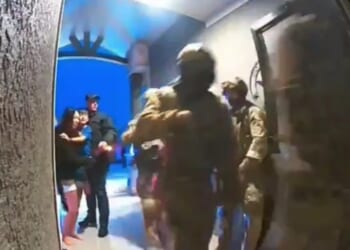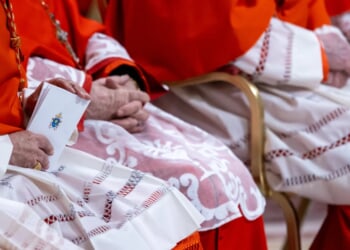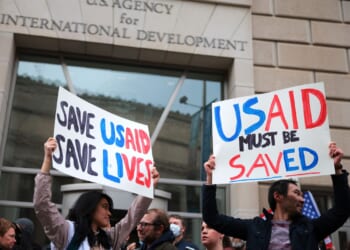A Mexican Navy training ship lost power and collided with the Brooklyn Bridge, killing two Mexican Seamen. Strong currents, mechanical failure, and lack of local knowledge contributed to the tragedy.
On Saturday evening, a Mexican Navy sailing ship struck New York City’s famed Brooklyn Bridge, resulting in the death of two cadets, while twenty-two other crew members were injured. The training tall ship ARM Cuauhtémoc lost power around 8:30 pm and was dragged towards the bridge by the strong currents in the East River. All three of the ship’s masts collapsed due to the allision (when a vessel strikes a stationary object).
The training ship departed Acapulco, Mexico, in early April and was on a 254-day international tour that included port visits to New York and Aberdeen, Scotland, where it was to participate in the city’s Tall Ships race in July.
According to Newsweek, “the Cuauhtémoc, a 297-foot-long sailing vessel first launched in 1982, is a ship used primarily for training Mexican naval cadets and typically makes international goodwill voyages to various ports.”
The National Travel Safety Board (NTSB) is already investigating the accident.
Did the Mexican Navy’s Ship Malfunction?
There is speculation that turbulent waters contributed to the ARM Cuauhtémoc collision with the bridge. However, several other factors were at play.
“While the cause of the allision is not yet known, reports are suggesting that loss of power due to mechanical failure in the vessel’s propulsion system may have played a role in the casualty,” explained José Cot, director in the New Orleans law firm of Hurley and Cot, APLC, and whose practice focuses on maritime personal injury and property damage.
“The vessel is reportedly fitted with a controllable pitch propeller system and a single auxiliary engine. Failure of CPP systems has also resulted in previous sudden, full-astern thrust vessel casualties,” Cot told The National Interest via email.
The East River, which separates the borough of Manhattan from Brooklyn and Queens, is heavily trafficked with commercial tugs, tows, deep-draft ships, sightseeing vessels, and large civilian-owned power boats.
“Likely, the tall ship lost power and couldn’t navigate in the strong currents and direction towards the bridge. This is similar to what reportedly occurred during the Francis Scott Key (Baltimore) Bridge collision and collapse in 2024,” added Jason Margulies, partner and attorney at Lipcon, Margulies and Winkleman, a leading maritime law firm.
Margulies told The National Interest that when the ship lost power and reserve power, it had no navigational capabilities.
“It is subject to the previous direction when the ship was under power and the currents of the navigable waterway,” Margulies noted.
Saturday’s incident reminds us that even experienced sailors can be caught off guard in unfamiliar waters. The loss of power, the strong current, and the crew’s lack of knowledge of the East River created an unfortunate scenario.
“This is always a possibility—the East River has strong currents and the wind was reportedly northeasterly (towards the bridge) at the time of the allision. On the other hand, it has been reported that a twin-screw assist tug was not connected to a towing hawser, and could not intervene before the allision,” said Cot.
All ships can be subject to a loss of power, but the crew was not prepared for the situation.
Margulies further suggested that even with redundant power systems to be used in emergencies, the switching to emergency power systems takes time that may not have been available on Saturday, as the ship was in a narrow waterway filled with obstacles.
“The East River is known for its strong currents, narrow channel, and multiple bridges, which require exact navigation,” Margulies continued. “The navigational rules require the ship to maintain a course of navigation near the center of the river and to maintain proper navigation under challenging conditions. Changes in circumstances, such as loss of power or communication, collisions in these types of conditions are likely to happen.“
What Will Be Done Following the Mexican Navy’s Shipwreck
New safety measures will likely be implemented just a year after the collision involving Baltimore’s Francis Scott Key Bridge.
“Statutes are in place that empower authorities such as the New York Port Authority to establish safety measures to protect navigable waters and structures, including bridges, from harm caused by ship operations,” noted Margulies.
“Empowered authorities can create stricter navigation protocols, enhanced risk assessments, and the establishment of safety zones in the navigable waterway.”
He added that it is still challenging to implement safety systems to prevent ships that have lost power from colliding with fixed objects that the waterway’s currents will bring them into contact with.
“The ships can drop anchor and try to switch to emergency power, but both of those solutions take time, which may not be available when navigating in narrow waterways filled with fixed obstacles, such as bridges,” warned Marguiles.
Municipalities with maritime or river traffic and bridges will likely take note of this past weekend’s incident.
“It will certainly bring renewed focus on safety considerations,” said Cot. He said that could include “operational procedures concerning assist tugs, proximity to bridges, and familiarity with the waters and location.”
About the Author: Peter Suciu
Peter Suciu has contributed over 3,200 published pieces to more than four dozen magazines and websites over a thirty-year career in journalism. He regularly writes about military hardware, firearms history, cybersecurity, politics, and international affairs. Peter is also a Contributing Writer for Forbes and Clearance Jobs. He is based in Michigan. You can follow him on Twitter: @PeterSuciu. You can email the author: [email protected].
Image Credit: Wikimedia Commons/ Baku13.















